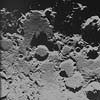| . |  |
. |
Shenyang, China (XNA) Apr 20, 2005 Chinese scientists say they have worked out a group of secondary robots which resemble wheels of a vehicle to carry out exploration missions on the moon. The robot series are an array of independently-controlled, concurrent and reconfigurable secondary robots, each consisting ofan arm for carrying objects, collecting samples, surveying and mapping, and a triangular wheel for independent walking and skipping obstacles, said a spokesman for the Automation Institute of the Chinese Academy of Sciences (CAS). The institute, based in Shenyang, capital of northeast China's Liaoning Province, is the independent developer of the robots which have passed the appraisal test by the Chinese government. These secondary robots are like wheels of the moon rover, whichis also made up of a primary robot, the bodywork of the vehicle, said the CAS spokesman who declined to be named. "The system will begin working when all the secondary robots' arms are linked to the primary robot, and a precise positioning system will help the whole system achieve concurrent and automatic-coperation," he said. "The secondary robots can be sent to different missions collecting data or removing any obstacle and automatically return to the main system." The reconfigurable system will play a leading role in China's future explorations to the moon or other planets, he said. The Chinese government has also announced its plan to launch a satellite to orbit the moon by 2007 as part of China's three-stagelunar project. Moreover, the country plans to land an unmanned rover on the Moon for collecting Lunar soil samples around 2020. Enditem Source: Xinhua News Agency Related Links Slooh SpaceDaily Search SpaceDaily Subscribe To SpaceDaily Express
 Paris (ESA) Apr 18, 2005
Paris (ESA) Apr 18, 2005ESA's SMART-1 mission to the Moon has been monitoring the illumination of lunar poles since the beginning of 2005, about two months before arriving at its final science orbit. |
|
| The content herein, unless otherwise known to be public domain, are Copyright 1995-2006 - SpaceDaily.AFP and UPI Wire Stories are copyright Agence France-Presse and United Press International. ESA PortalReports are copyright European Space Agency. All NASA sourced material is public domain. Additionalcopyrights may apply in whole or part to other bona fide parties. Advertising does not imply endorsement,agreement or approval of any opinions, statements or information provided by SpaceDaily on any Web page published or hosted by SpaceDaily. Privacy Statement |